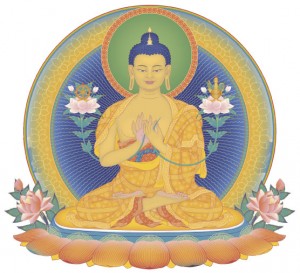Lojong Meditations in Tibetan
Buddhism
LOJONG is the generation of bodhicitta (great compassion) through the practices of equalising and exchanging self with others, combined with taking and giving. The meditations of equalising and exchanging self with others are designed to reduce the practitioner's self-cherishing (one of the causes of uncontrolled samsaric rebirth) and encourage her to cherish others (a means of progressing along the path to enlightenment). A very powerful and profound meditational practice is that of mounting taking and giving upon the breath, where the meditator visualises that every time she breathes in she takes on the sufferings and obstructions of others (usually visualised as thick, acrid, black smoke), and everytime she breathes out she radiates happiness, healing and virtuous actions to them (usually visualised as white light). The idea of breathing in others' suffering may seem strange at first, but according to the Kadampa teachings [REF 1] these sufferings do not settle upon us, but in fact extinguish our own negativities and self-cherishing, making us feel calm and loving. Those of us given to scientific modes of thought may think of the sufferings of others meeting our own negativities being like matter meeting anti-matter. They annihilate each other in a huge burst of pure, healing energy which radiates outwards and gives peace and happiness to all the surrounding sentient beings. Most meditations require quiet and peaceful conditions, but taking and giving can be performed anywhere, even when walking down a crowded street or in a train at rush hour. The meditator observes all the people rushing past her, or on the train, and reflects upon their worries, sorrows and illnesses. With each incoming breath she pulls the unhappiness out of them, and with each outward breath she gives them peace, happiness and health. - Sean Robsville [REF 1] Geshe Kelsang Gyatso 1995, Joyful Path of Good Fortune 2nd Edn; publ London: Tharpa ISBN 0 948006 46 3 p 424 - 445 See also: Buddhist Teachings Developing compassion
RATIONAL
BUDDHISM |
